The Boomerang of Deep Time:On Wang Jianwei’s exhibition “Treading in Sludge” and Michael Wang’s “Lake Tai”
| July 14, 2023
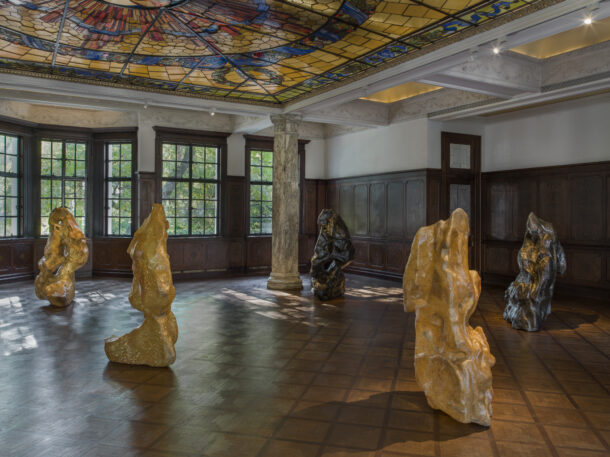
Micheal Wang’s solo exhibition “Lake Tai”, 2022, installation view, Prada Rong Zhai, Shanghai
Courtesy the artist and Prada Rong Zhai
Perhaps one of the most frequently discussed notions of 2022 will be the “end” of globalization. Three years into the pandemic, we have witnessed events ranging from China’s large-scale lockdowns and border closures, to the rise of far-right parties in Europe, policies defending domestic economic interests, restrictions on social mobility, and scaled-back investment in order to meet carbon neutrality targets (including fossil fuel phaseout and other measures to curb global warming). Sweden, assumedly in the vanguard of environmental governance, has elected a far-right government that’s decided to scrap the Ministry for the Environment as a standalone department responsible for environmental policies, placing it under the Ministry for Energy and making huge cuts in green funding for climate strategies. The COP27 global climate summit concluded without offering substantive proposals for controlling global warming. Demands by the developing world that the wealthiest countries pay for their excessive carbon emissions also went unheeded. Unsurprisingly the summit was overlooked by social media and the public in China.
Are we really placing the fate of the Earth on nation-states’ political policies and financial budget monitoring, and imagining these actions vanquishing the energy, environment and climate crisis? Any answer will be controversial. In discussing the globalization of environmental issues, the ecocritic Ursula Heise has coined the notion of eco-cosmopolitanism and suggested an inclusive and mutually constitutive relationship between a “sense of place” and a “sense of planet”; the environment as an issue is not a patchwork of distinct local issues in fragmented localities, but a total fact calling for global awareness. The history of mankind, written in terms of exploration, exploitation, war, slavery, colonization, and plunder, is ultimately a history of preying on Earth’s resources. The photons emitted from the deepest time in the cosmos continue to influence our current lives and our future, but how is such power manifested? Are we aware of the deep imprint of Earth’s history upon our humanity now and then? How can we perceive a waterscape that contains networks of contemporary geographical and social constructs (including kinship) through an understanding of ecological changes? Recent art exhibitions in Shanghai––Wang Jianwei’s solo “Treading in Sludge” at MadeIn Gallery and Michael Wang’s “Lake Tai” at Prada Rong Zhai––both consider humanity’s bond with the Earth. The artists’ senses of place and planet are not mere chance encounters; although they differ in research methodologies and their rationales are manifested in different artistic practices and media, they both invite the audience to contemplate the ecological issues conveyed by these paintings, sculptures, and site-specific installations, and to destabilize the anthropocentric obsession with determining Earth’s fate.
Here is MadeIn Gallery’s space, located in a sunken plaza along the Suzhou River. Viewers are met by a visual composite of huge abstract sculptures and relatively more realistic paintings of animals, complemented by raw concrete walls and exposed ventilation ducts. The African elephant in Wang Jianwei’s installation sends greetings. Perhaps, methodology-wise, the more precise name for this work should be Cambrian Rehearsal Grounds, as Wang is most familiar with interdisciplinary knowledge alloyed with scientific and philosophical metaphors that turn his rationale into tools for empowering contemporary art, at the heart of which is the artistic expression of his philosophical reflections on the multiplicity of time. Following Wang’s solo exhibition “Time Temple”, at the Guggenheim Museum in New York in 2015, he now points back in time to the 530-million-years-ago Cambrian period of Earth, into what is known as “deep time”. American writer John McPhee applied the concept of deep time, in his book Basin and Range (1981), to a documentation of his journey through ancient terrain in the canyons of Utah, USA. He writes, “Numbers do not seem to work well with regard to deep time. Any number above a couple of thousand years—fifty thousand, fifty million—will with nearly equal effect awe the imagination.”[1] So, how can humans, with a lifespan that seldom exceeds a century, possibly gauge Earth’s 4.6-billion-year evolution?
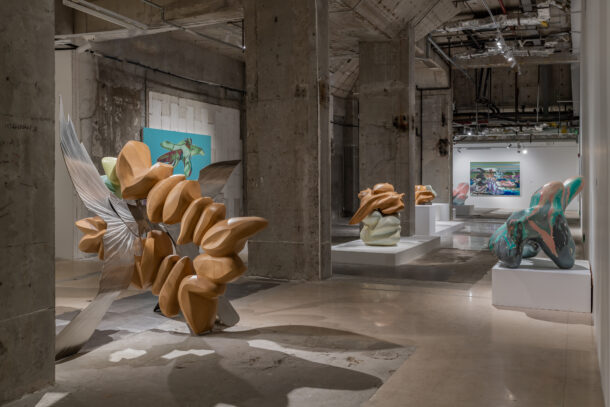
Wang Jianwei’s solo exhibition “Treading in Sludge”, 2022, installation view, Madeln Gallery, Shanghai
Courtesy the artist and Madeln Gallery
Awe is certainly a thread that connects Wang Jianwei’s philosophical and artistic thinking with the installations on display here that speculate about the Cambrian period. He has stated in materials for a 2018 exhibition that displayed works from the Cambrian installation series in Shanghai that “a dormant geological time may still have knowledge that we cannot possibly fathom at the moment. It is not just our wonder of geological longevity, but instead a fear at everything incomprehensible due to humans’ inability to share the same longevity and continuity. Geological time transcends humans’ predominant gauge of the world. Or, in other words, it never expects us to measure everything through the eyes of men.”[2] At MadeIn, these oddly shaped installations––for example, a stack of polished and painted wooden blocks around a pair of steel wings (Treading in Sludge No.3, 2022) and a well-structured steel plinth underneath a wooden dinosaurlike sculpture (Treading in Sludge No.6, 2022)––reveal a silky sheen on top of the finely assembled wood slices and stainless steel skeletons. These alloyed objects remind us of neo-materialist theories and the extended concepts for sculpture contained therein, especially “the weird” of Graham Harman’s Art and Objects (2019), “which has a precise technical sense: a situation in which objects exist in tension with their own qualities rather than being reducible to them.” [3]
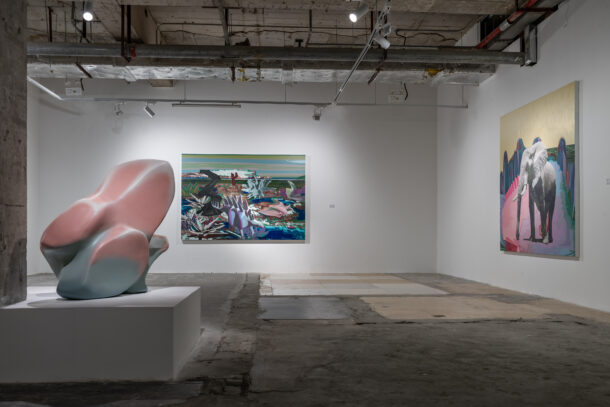
Wang Jianwei’s solo exhibition “Treading in Sludge”, 2022, installation view, Madeln Gallery, Shanghai
Courtesy the artist and Madeln Gallery
Harman’s tension is also articulated in Wang’s theatrical experiments. Sculptures are placed on lower plinths, and across them paintings depicting prehistoric landscapes form different points of view on a stage. The pixelated details seem to echo a contemporary scene of humans’ craving for the digital such as smartphones. While the remnants of the Cambrian explosion––the bio-mineralised organisms that are now fossils––were once the witness of single-celled organisms’ hunger for nickel (lack of nickel was one of the causes of the Great Oxidation Event and the Cambrian explosion), we humans are now watching another round of nickel chasing involving multinational mining companies. A retelling of the story of the sludge (a metaphor for anaerobe as the shelter for organisms to block oxygen invasion) has its genesis in MadeIn at the sunken plaza. Looking back on the tool-beings (a phrase used by Harman and emphasized by Wang Jianwei) of evolutions, civilizations, cognitive revolutions and posthuman object-oriented technologizations, as well as the actor-network (coined by Latour and suggested by Lu Xinghua, curator of the exhibition) that fits in contemporary art, I cannot help but again dwell on the various versions of a nonhuman Exodus hidden behind the sludge that entails a visual and metaphoric reincarnation of a specific deep time.
In a geological era some 50 million years ago, a meteorite struck the present-day Asian continent, leaving a crater thousands of kilometres wide and forming what is now called the Lake Tai. It is the third largest freshwater lake in China and is responsible for the daily drinking water for the 20 million local inhabitants, agricultural irrigation and the waterway linkage from Wuxi to Shanghai. However, the Yangtze River Delta, China’s leading economic region, is also home to a cluster of factories that discharge industrial wastewater into Lake Tai night and day. Since the 1990s, anthropogenic eutrophication of the lake has caused massive cyanobacteria blooms, the worst of which has caused water outages in Wuxi for days. The lake has then become a global symbol of degradation of freshwater ecosystems. According to an image taken by the European Space Agency, the lake is covered in an enchanting green that would almost distract us from the threatening nature of such microorganisms.

Wang Jianwei, Treading in Sludge No.13, 2021, oil on canvas, 113 × 163 cm
Courtesy the artist
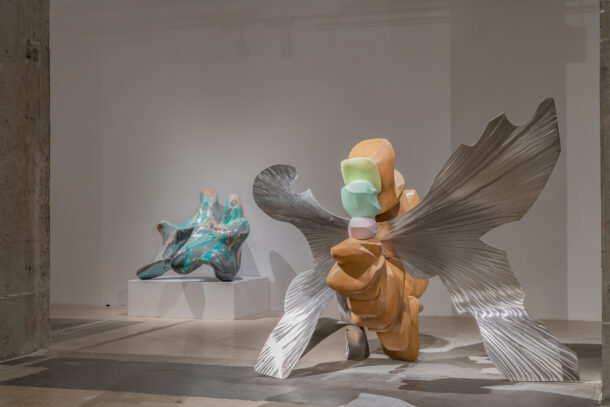
Wang Jianwei’s solo exhibition “Treading in Sludge”, 2022, installation view, Madeln Gallery, Shanghai
Courtesy the artist and Madeln Gallery
Wang Jianwei’s “Treading in Sludge” is an unearthing of a specific Earth’s time, whereas American artist Michael Wang’s exhibition at Prada Rong Zhai is a bottom-up approach to explore the social, the historical, and the dividual. Lake Tai as a point of departure provides Michael a context for his research in the lake’s environment interrupted by algae blooms and the technological interventions that aims to restore the healthy waterbody. He engages with waste from the techno-ecological treatments and crab shells due to annual consumption of hairy crabs, collaborating with students from Tongji University to develop materials for artworks. The journey he takes from Lake Tai via Wuxi to Rong Zhai in Shanghai also echoes the former owner of Rong Zhai’s sojourn more than a century ago, paving the way for Rong’s empire that owns a tremendous amount of asset including this luxurious western-style garden villa in central Shanghai—a swampy city that was once home for reed marshes. Part of artist Michael Wang’s identity connects with these locations as most of his father’s lineage came from Jiangsu or Zhejiang province, while his grandfather was from Wuxi and his father was born in Shanghai. Lake Tai in Michael Wang’s new works, becomes a hybrid body entailing natural, socio-cultural and technological narratives that confront specific localities and the wider world.
In the ballroom on the first floor, here stands a collection of unusual Taihu stones under the extraordinary skylight composed of panels of stained crystalline glass. Take a closer look at the stone’s textured surface flecked with recycled waste materials such as invasive water plants, algae (cyanobacteria) and crab shells. You would wonder how the artist has transformed the valueless waste into a new technological sublime. The long-term erosion from carbonic acid rendered the irregular craggy surfaces and openings of admired by ancient Chinese literati and garden landscape architects who often considered the stones an embodiment of taste, an object of imagination and a miniature of nature. The spirit within traditional Chinese culture’s imagery of landscape has never left Lake Tai, even though it has been defiled by industrial if not anthropogenic pollution. There, the useless waste materials are the cyborg bodies of oddly aesthetic stone grottos weathered by an anthropocentric assemblage of historical events, cultural symbols, personal and economic interests, ecological urgencies and ancient microbes.
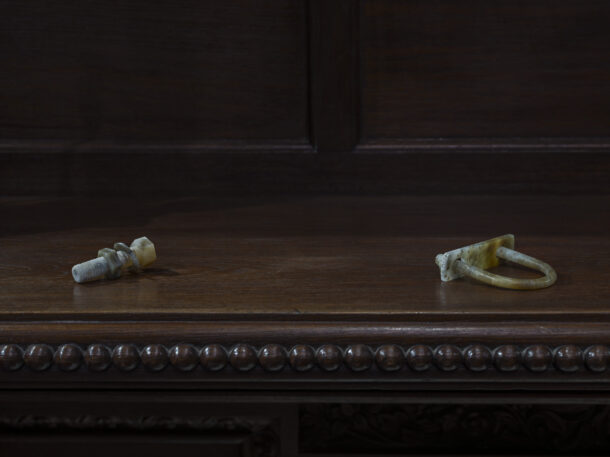
Michael Wang, Shaft 1, Ring 1, Disk 1 (preparatory study), and Assembly 2 (preparatory study), from the series “Artifacts (Jade)”, 2022
Micheal Wang’s solo exhibition “Lake Tai”, 2022, installation view, Prada Rong Zhai, Shanghai
Courtesy the artist and Prada Rong Zhai
The ephemerality of contemporary art exhibitions concerns artists that are often ambitious about creating works that would be more than ephemeral spectacles. Reflecting on the general question of a life span of artworks and the heated issue of carbon footprint, Michael Wang has been ecologically conscious of his materials. For his solo project Carbon Copies ten years ago, Wang selected artworks from a range of well-known contemporary artists and represented them in cube-shaped copies. These sculptures were priced at the amount required to offset carbon footprint for producing the original artworks. Wang makes it clear that he has no intention of gaslighting other artists’ practice, but only insists on practicing relevant technologies to care for the planet. For the exhibition in Rong Zhai, Wang continued with such an awareness, utilizing algae from Lake Tai for the hairy crab sculptures in a boat and concrete from demolished buildings along the Suzhou River for Suzhou Creek (piles) (2022) in the sunroom. Towards a Harmanian object-oriented ontology that considers all objects existing on equal footing, Wang reveals his wish for a state of hybridity in which all things, whether humans or nonhumans, can be given equal and unbiased respect. At the forefront of climate change action, Wang offers an alternative to the widely discussed approaches for sustainable materials in contemporary art.
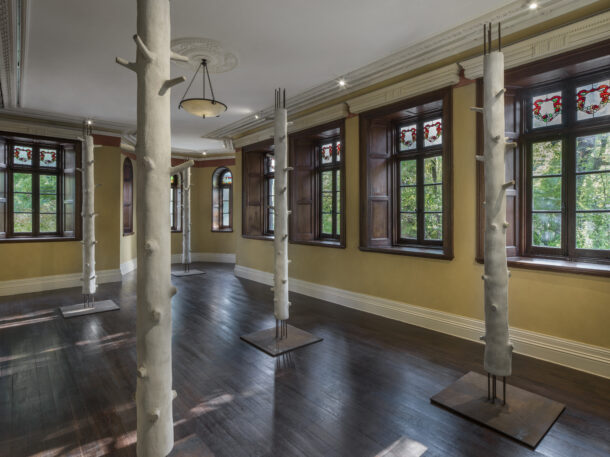
Michael Wang, Piles(preparatory study), from the series “Suzhou Creek (Piles)”, 2022
Micheal Wang’s solo exhibition “Lake Tai”, 2022, installation view, Prada Rong Zhai, Shanghai
Courtesy the artist and Prada Rong Zhai
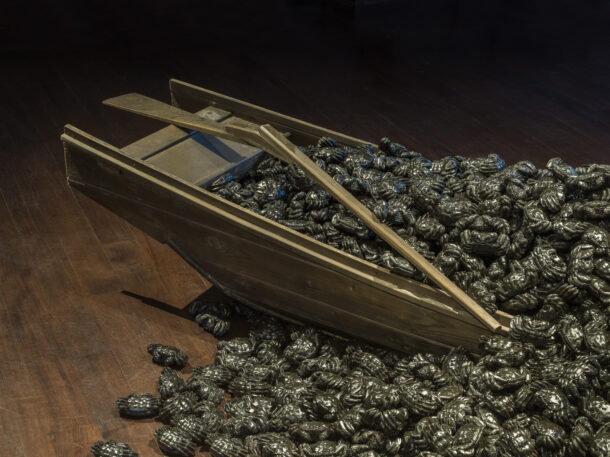
Michael Wang, Taihu Crab (preparatory study), 2022
Micheal Wang’s solo exhibition “Lake Tai”, 2022, installation view, Prada Rong Zhai, Shanghai
Courtesy the artist and Prada Rong Zhai
The cyanobacteria investigated by Michael Wang for the exhibition “Lake Tai” are among the oldest living organisms on Earth, which triggered the Great Oxygen Event 2.6 billion years ago and thence a planetary change. A geophysical evolution, as well as an ecological revolution occurred. The blue algae also seemed to be resonating with Wang Jianwei’s object, the Cambrian. As the microbes silently and steadily released oxygen, they provided the conditions for more living bodies, leading to an explosion of life in the relevant era. No one would have thought that the cyanobacteria, the harbingers of an evolution of such magnitude, are responsible for the transformation of microorganism into organism, the formation of a hospitable planet, and the creation of human society. At the end of 20th century, cyanobacteria triggered yet another ecological crisis in the Yangtze River Delta that includes some of the fastest-growing economies. It is the nature’s declaration of war on mankind. Still, are we trapped in the iconography of anthropocene? How can we recognize the urgency and importance of the heated issues such as climate change, carbon emissions and renewable resources? The indifference towards climate change is common. Artist and environmental activist Olafur Eliasson responded to such attitude, suggesting that culture has the power to make sense of knowledge and prompt action, “[a]rt deals with the relationship between personal and shared experiences… A work of art can contribute to the creation of a sense of community or reciprocity, and it can motivate us to do something together, to become conscious and active members of a global we, without surrendering our personal, emotional experiences.”[4] Both Wang Jianwei and Michael Wang’s exhibitions are boomerangs that fly to different Earth times. While the former points to the deep history of Earth, revealing a contemporary imagination of the source of life and its asylum—figuratively, the sludge—along with the technological nature of contemporary society, the latter returns to the present, suggesting the possibility of art and action for the sake of nature, history and humanity.
[1] Alden, Andrew. “What is Deep Time?” ThoughtCo, Jul. 30, 2021, thoughtco.com/what-is-deep-time-1440836.
[2] Wang Jianwei, foreword to the exhibition “Cambrian”, http://wangjianweistudio.com
[3] https://tzvetnik.online/article/graham-harman-as-for-how-the-object-resists-being-exhausted-i-don-t-think-it-needs-to-resist
[4] Olafur Eliasson, “Ice, Art, and Being Human,” https://olafureliasson.net
Translated by Harriet Min Zhang

